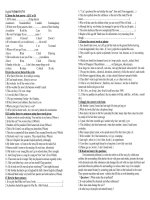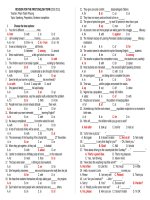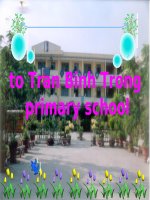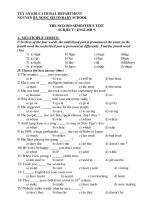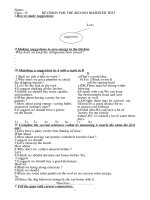REVISION ENGLISH 9 1st SEMESTER
Bạn đang xem bản rút gọn của tài liệu. Xem và tải ngay bản đầy đủ của tài liệu tại đây (151.66 KB, 7 trang )
<span class='text_page_counter'>(1)</span>NỘI DUNG ÔN THI KIỂM TRA HỌC KÌ I MÔN: TIÊNG ANH.9 NĂM HỌC: 2012- 2013 A. Listening: (nghe): Xem các bài nghe từ bài 1 đến bài 5 B. Language Focus: Học từ vựng từ bài 1 đến bài 5 Bài 1: correspond, impressed, mosque, pray, climate, religion, Islam, Buddhism, population, separate = divide (into), compulsory, Bài 2: poet, poem, tunic, inspiration, ethnic, minorities, pattern, design, designer, alternative, announcement, entrance, fair, doll, material, sailor, wear out, embroider, label, style, argue, argument, encourage, equal, bear, freedom, confident, Bài 3: exchange, maize = corn, part – time, grocery store, baseball, hot dog, member, rout, pond, pick somebody up,, parking lot = car park, journey, bamboo forest, banyan tree, shrine, snack, river bank, blanket, lay out - (laid), gather= collect, site, catch Bài 4: written examination, oral examination, college, candidate, examiner, aspect, scholarship, abroad, dormitory, campus, reputation, native speaker, persuade, introduce, international bank, national bank, forget – forgot – forgotten, terrible, council, intermediate, advanced, well-qualified, academy, tuition, request, detail, fee, edition, express, exactly, polite Bài 5: a crier, shout, variety, channel, remote control, benefit, documentary, violent, informative, assignment, century, newsreel, appear, telegraph, journalism, forum, surf, deny= refuse, get access to, spam, alert, wander. I. Tenses: (CÁC THÌ) 1. Thì hiện tại đơn ( simple present tense): nhận biết:often, usually, always, sometimes, never, seldom, everyday…….. a. TO BE: S + am / is / are………….. S + am not / is not / are not….. Am / Is / Are + S …………..? b.Động từ thường: S + V / V ( s/ es )…………… S + do not / does not + V (inf)…….. Do / Does + S + V ( inf )……..…. ? Lưu ý: I/ We/ You/ They + V She/ He/ It + V(es/ s) –nếu động từ tận cùng là: o, sh, ss, ch, x, z thì ta thêm “es” Thì quá khứ đơn ( simple past tense) :yesterday, last, ago, in + năm trong quá khứ…. … a. TO BE : 4. Thì hiện tại tiếp diễn ( present progressive tense) now, right now, at the moment, at present,…. S + was / were…………. S + am / is / are + V-ing……. S + am not / is S + was not / were not….. not / are not + V-ing….. Am/ Is / Are+ S + V-ing………? Was/ Were + S……….. ? b. Động từ thường: 5. Thì quá khứ tiếp diễn ( past progressive tense): at that time, then, at + giờ + yesterday / last S + V ( ed / 2 )……………… S + was / were + V-ing……… S + was not / were S + did not + V (inf )………... not + V-ing…. Did+ S + V ( inf ) ………….? Lưu ý: I/ She/ He/ It + was We/ You/ They + were 3. Thì tương lai đơn ( simple future): tomorrow, next, tonight,…. S + will + V ( inf )………. S + will not + V ( inf )……. Will + S + V ( inf )………?. Was / Were+ S + V-ing…………? 6. Thì hiện tại hoàn thành ( present perfect tense): since , for , lately , recently , yet , already , up to now , several times ,… .. S + have / has + V(ed/3)………. S + have not / has not + V ( ed/3)……… Have / Has + S + V (ed/3) …………?.
<span class='text_page_counter'>(2)</span> Lưu ý: I/ We/ You/ They + have She/ He/ It + has II. Wish– sentence: ( câu ao ước) - Xem bài tập 1 trang 28-29 –SGK. EX 2: He said to me: “Do you like bananas?”=> He asked me if / whether I liked bananas. c. WH – question EX1: Lan asked me: “Where are you from? “ => Lan asked me where I was from. S + be ( were ) EX2: Tom asked me: “What do you buy? “ Loại I S + WISH (es) S + V ( 2/ed ) now, today => Tom asked me what I bought. S + did not + V ( inf ) Các bước đổi sang câu tương thuật: S + would/ could + V ( inf ) -tomorrow, tonight 1.Đổi thì: EX: I wish I (have) a bike now. I wish I had a bike Direct speech (câu trực tiếp) now. HTĐ QKĐ III. Conditional sentence: ( câu điều kiện) – xem bài HT tiếp diễn QK tiếp tập 1trang 38 (SGK ) T. lai đơn ( will + V ) T. lai tr can could Mệnh đề IF Mệnh đề chính may + V ( inf ) might should must had to have to 2. Đổi ngôi thứ: Hieän taïi ñôn (S + V(s/es) S + ought to + V ( inf ) a. Nhất- chủ must b. Nhì – túc might c. Tam – nguyên EX: If you want to attend the course, you should pass Ngôi thứ S(chủ từ) O(túc từ) the written examination. I I me IV. The passive form :( câu bị động) cho tất cả các thì We us trên. xem bài tập 4 và 5 trang 21- SGK II You you 1. Đổi túc từ => chủ từ. They them S (chủ từ) O (túc từ ) S (chủ từ) III She her I me She He him We us He It it You you It 3. Đổi trạng từ: They them Direct speech (trực tiếp) Reported spe 2. Đổi động từ => V ( 3/ ED ). this that 3. Đặt “BE” phải phù hợp với chủ ngữ, ngay these those here there trước V(3/ED). then Hiện tại đơn Quá khứ đơn T. lai đơn H. tại tiếp diễn/ Q.now khứ tiếp diễn today / tonight that day / that n am / is / are was / were be tomorrow the following d 4. Đổi chủ từ => By- O (Ở câu bị động ta bỏ: by Ví dụ chung: I asked me “Will you leave them/ by someone/ by somebody/ by people) me alone tomorrow?” 5. Trạng từ chỉ nơi chốn đặt trước: By + O (thì) (ngôi) EX: Taxis and buses are taking tourists (ngôi) (trạng từ) around the city . I asked me if I would leave S V O me alone the following day. (trạng từ nơi chốn) VI. Prepositions of time: ( giới từ) Xem bài tập 2 và 3 trang 03 (SGK ) Unit 3. -Tourists are being taken around the Giới từ chỉ thời gian: city by taxis and buses. - ON (vào) + ngày, thứ V. The reported speech: (câu tường thuật). Xem bài - IN(vào) + tháng/ năm/ mùa/ buổi ập 3 và 4 trang 39 ( SGK ) - AT (vào lúc) + giờ/ night/ weekend. a. Statement: - BETWEEN………and………….: EX: She said:” I am a student. => She said giữa……….và……… (that) she was a student. - AFTER: sau khi b. Yes - No question - BEFORE: trước khi EX1: She said to me: “Are you a student?” - TILL: cho đến khi => She asked me if / whether I was a VII. Tag– question:(câu hỏi đuôi)- Xem bài tập 4 student. trang 39..
<span class='text_page_counter'>(3)</span> Statement Khẳng định Phủ định EX: -An: You don’t like watching sports programs on TV, do you? Tania: No, I don’t. -Hoa: He can swim, can’t he? Lan: Yes, he can. VIII/ Gerund: (danh động từ) – Xem bài tập 3 trang 38 (sách bài tập) Like (thích)/ dislike(không thích)/ love(thích)/ enjoy(thích)/ hate(ghét) + V-ING EX: I like playing soccer. 1. Put the verbs in the correct form: (sử dụng động từ đúng trong ngoặc đơn) 1. The girl (visit)……………………..Ho Chi Minh Mausoleum last year. 2. You ever (eat) Vietnamese food? =>........................you……………Vietnamese food? 3. We (visit) ………………….Giac Lam Pagoda since last week. 4. I don’ have a long vacation. I wish I (have) …………………………a long vacation. 5. I am not a good student. I wish I (be) ………………… a good student. 6. They I wish I (be) ……………a good student now. 7.Ba wishes he (can)………………….. have a new bicycle. 8. If you want to attend the course, you (pass) …………………… the written examination. 9. You (like) ………………………watching sports, don’t you? 10. He went to Nha Trang last week, …………. ……..he? 11. Lan (can)…………………swim, can’t she? 12. You are a student, …………………….you? 13. They enjoy (play) ………………………..football. 14. I love (listen)……………..………….to pop music. 15. She enjoys (watch)………………….. TV. 16. It is raining heavily …………….they can’t go to the beach.(so/ because/ but) 2. Change these sentences into the passive form:(đổi sang câu bị động) 1. My mother cleans the room everyday. =>The room………………………………………………… ……………………………………… 2. He painted a picture of Ha Noi. =>A picture of Ha Noi ……………………………………………………… ..……………………. 3. Lan has studied English for five years. => English……………………………………………… ………………………………………… 4. They will repair the houses. => The houses……………………………………………… ……………………………………… 5. They have built the new building since 2005. => The new building…………………………………………… ………………………………… 3. Fill in the blanks with the correct preposition of time: (điền đúng giới từ chỉ thời gian) 1. They often go swimming ………….. …….Sunday. 2. She will be thirteen ……………………..her next birthday. 3. We are playing chess …………………..the moment. 4. It often rains ………………………………….July. 5. My birthday is ………………………….September 13th. 6. The party will start ……………..7 o’clock …………….the evening. 7. He was born ……………………April, 2002. 8. On Tuesday morning, there is a meeting …………11 am and 1 pm. 9. It‘s often cold ……………..Winter. 4. Complete the sentences with the reported speech: (đổi sang câu tường thuật) 1. Aunt Xuan said: “I am happy to see him “ => Aunt Xuan said………………………………………………… ……………………………. 2. He said:” I like coffee“ => He said……………………………………….. ……………………………………………… 3. He asked me: “ Do you like My Son?” => He asked me………………………………………………… …….………………….……... 4. She asked me:” are you a student?” => She asked me………………………………………………… ……………..………………… 5. Lan asked me:” Do you live in a city?” => Lan asked me………………………………………………… ………………………………... 6. She asked me:” Where are you from?” => She asked me………………………………………………….. ……………………………… 7. He asked me:” How do you learn English?”.
<span class='text_page_counter'>(4)</span> => He asked her………………………………………………… ………………………………… 5. Stress syllable: (nhấn âm) option, region, religion, fashion. inspiration, collection, reputation, limitation, communication, control, deny, relax, divide(into), impress, listen, separate, notice, label, locate, order, public, gather, climate, uniform, casual, pagoda, material, campus, institute, Internet, remote, violent. 6. Đọc các câu sau đây và điền từ thích hợp vào ô trống: 1. I don’t know English. I want to attend the course for…………………..(beginner/ intermediate/ advanced) 2. Is Buddhism…………………….?(population/ religion/ region) 3. The traditional dress of Japan women is…………………(ao dai/ sari/ kimono) 4. In Viet Nam, Students in secondary schools should wear……………when they are at school. (jeans/ casual clothes/ uniform) 5. Town criers, newspaper, magazines and TV are the………………(news/ media/ newsreel) 6. The………………is the traditional dress of Vietnamese women. (ao dai/ sari/ kimono) 7. I speak a little English. I want to improve my……………..skill.(listening/ writing/ speaking) C. READING: (đọc hiểu). climate capital 1. Đọc đoạn văn và làm bài tập bên dưới: Malaysia is one of the (1)___________ of the Association of South East Asian Nations (ASEAN). It is divided (2)____________ two regions, known as West Malaysia and East Malaysia. They are separated by about 640 km of the sea and together comprise an area of 329,758 sq km. Malaysia enjoys tropical (3)_______________ . The Malaysian (4)_______________ of currency is the ringgit, consisting of 100 sen. The (5)______________ of Malaysia is Kuala Lumpur and it is also the largest city in the country. The population in 2001 was over 22 million. Islam is the country’s official religion. In addition, there are other religions such as Buddhism and Hinduism. The national language is Bahasa Malaysia. a. Đọc đoạn văn và điền từ vào ô trống: b. Đọc đoạn văn và trả lời câu hỏi: 1. Was the population in 2001 over 22 million in Malaysia? …………………………………………………… ……………………………………………… 2. Is Islam or Buddhism the country’s official religion?. …………………………………………………… ……………………………………………… 3. What is the national language in Malaysia? …………………………………………………… ……………………………………………… 2. Đọc đoạn văn và làm bài tập bên dưới: The word jeans comes from a kind of material that was made in Europe. The material called jean, was named after sailors from Genoa in Italy, because they wore clothes made from it. In the 18 th century jean cloth was made completely from cotton and workers at that time loved wearing it because the material was very strong and it did not wear out easily. In the 1960s, many university and college students wore jeans. Designers made different styles of jeans to match the 1960s’ fashions: embroiders jeans, painted jeans and so on. In the 1970s more and more people started wearing jeans because they became cheaper. In the 1980s jeans finally became high fashion clothing, when famous designers started making their own styles of jeans, with their own labels on them, Sales of jeans up and up. But in the 1990s the worldwide economic situation got wore, and the sales of jeans stopped growing. However, jeans have never been out of fashion, and today young generation is still fond of wearing them. a. Đọc đoạn văn và điền từ vào ô trống: 1. In the 18th century, workers like to wear jeans because the material made from cotton was very strong and could hardly……………out.(make/ wear/ come) 2. In the………….., many university and college students wore jeans.(1960th / 1970th / 1980th ) th into 3. countries unit In the 1970 , jeans became…………………….. ……, many people begin wearing jeans.(more expensive/ nicer/ cheaper) 4. In the 1980th, Jeans became high…………………..clothing.(uniform/ designer/ fashion) b. Đọc đoạn văn và trả lời câu hỏi: 1. Does the word jeans come from Genoa in Italy? …………………………………………………… ……………………………………………… 2. What were the 1960s’ fashions? …………………………………………………… ……………………………………………… 3. Did jeans become expensive in the 1970s? …………………………………………………… …………………………………………….... 3. Đọc đoạn văn và làm bài tập bên dưới: Van, a student from Ho Chi Minh, is an exchange student in the USA. He is now living with the Parker family on a farm 100 kilometers outside Columbus, Ohio. He will stay there till the beginning of October. Mr. Parker grows maize on his farm, while Mrs. Parker works part- time at a grocery store in a nearby town. They have two children. Peter is the.
<span class='text_page_counter'>(5)</span> same age as Van, and Sam is still in primary school. Since Van arrived, he has been learning a lot about life on a farm. In the afternoon, as soon as he completes his homework, he feeds the chickens and collects their eggs. On weekends, if Mr. Parker is busy, the three boys help him on a farm. On Saturday afternoon, Peter plays baseball. The Parker family and Van eat hamburgers or hotdogs while they watch Peter play. The Parkers are nice so Van feels like a member of their family a. Đọc đoạn văn và điền từ vào ô trống: 1. Mr. Parker is a______________________________. 2. Mrs. Parker works part time at a grocery _____________________in a nearby town. 3. They have two_____________________, Peter and Sam. 4. On Saturday afternoon, Peter often plays ____________________. b. Đọc đoạn văn và trả lời câu hỏi: 1. Where is Van from? …………………………………………………… ………………………………………………... 2. Will he stay in the USA till the beginning of October or November? …………………………………………………… ………………………………………………... 3. What does he do after school? …………………………………………………… ………………………………………………... 4. Does he like the Parkers? …………………………………………………… ……………………………………………….... 2. Viewers are able to ask questions about the show by using ________________ control. b. Đọc đoạn văn và trả lời câu hỏi: 1. Is Kien Thuc Ngay Nay widely read only by teenagers? 2. Does TV bring benefits to people’s life? D. WRITING: (Viết) 1. Viết một lá thư cho gia đình khi em đang viếng thăm nơi nào ở Việt Nam: I / arrive/ Da Nang airport/ late/ afternoon / Tuesday. Hoa/ meet/ me/ airport,/ then/ she/ take/ me/ home/ taxi. I/ visit/ many places/ like the beaches/ Cham Museum/ Marble Mountains/ supermarket/ the water park./I / try/ different foods/ such as/ sea food. I/ feel/ happy/ and enjoy/ myself/ so much. The people/ here/ so nice/ and friendly, /the food/ so delicious/ and the sights/ so beautiful. I /will / leave/ Da Nang/ 2 pm/ next Thursday./and I/ will arrive/ home/ 11 pm./ Please pick/ me/ up / the airport. ………………………………………………………… ……………………………………………… ………………………………………………………… ……………………………………………… ………………………………………………………… ……………………………………………… ………………………………………………………… ……………………………………………… ………………………………………………………… ……………………………………………… ………………………………………………………… ……………………………………………… ………………………………………………………… ……………………………………………… ………………………………………………………… ……………………………………………… ………………………………………………………… ……………………………………………… ………………………………………………………… ……………………………………………… ………………………………………………………… ……………………………………………… ………………………………………………………… ……………………………………………… ………………………………………………………… ……………………………………………… ………………………………………………………… ……………………………………………… ………………………………………………………… ………………………………………………. 4. Đọc đoạn văn và làm bài tập bên dưới: THE MEDIA A. Before newspapers were invented, town criers would go through city streets ringing a bell. They shouted the latest as they were walking. B. In Viet Nam people love reading newspapers and magazines. The Kien Thuc Ngay Nay is one of the most popular magazines and is widely read by both teenagers and adults. C. Thanks to television people can get the latest information and enjoy interesting programs in an inexpensive and convenient way. Nowadays, viewers can watch a variety of local and international programs on different channels. D. The next in the development of television is interactive TV. Viewers are able to ask questions about the show by using their remote 2. Viết một đoạn văn khoảng 50- 80 từ để ủng hộ lý lẽ controls. cho rằng học sinh nên mặc thường phục đến trường: a. Đọc đoạn văn và điền từ vào ô trống: 1. The Kien Thuc Ngay Nay is one of the Secondary popular school students should wear casual clothes of ________________________. Wearing casual clothes:. -. makes students feel comfortable. gives students freedom of choice..
<span class='text_page_counter'>(6)</span> ………………………………………………………… ……………………………………………… ………………………………………………………… ……………………………………………… 4. Viết một đoạn văn kể về chuyến đi giã ngoại ở vùng quê: I think it is necessary for secondary school students to It/ beautiful day. My friends/ and I/ decide/ to go/ on/ wear ………………………………………… picnic . We/ take/ bus/ countryside/ and then / we/ ………………………………………………………… walk/ 20 minutes/ picnic site/ river. We/ put down/ ……………………………………………… blankets / and lay out/ food. After meal/ we/ play/ ………………………………………………………… games/ “What song is it?”. Late/ afternoon/ we/ go/ ……………………………………………… fishing. We/ enjoy/ our picnic. When we/ look/ the ………………………………………………………… time, it/ nearly/ 6.30 Pm. We/ hurriedly/ gather/ things/ ……………………………………………… and run/ bus stop. We/ lucky/ catch/ last bus/ and we/ ………………………………………………………… arrive home/ very late/ evening. ……………………………………………… It was a beautiful day. My ………………………………………………………… friends………………………………………………. ……………………………………………… …………………… ………………………………………………………… ………………………………………………………… ……………………………………………… ……………………………………………… ………………………………………………………… ………………………………………………………… ……………………………………………… ……………………………………………… ………………………………………………………… ………………………………………………………… ……………………………………………… ……………………………………………… ………………………………………………………… ………………………………………………………… ……………………………………………… ……………………………………………… ………………………………………………………… 3. Viết một đoạn văn khoảng 50- 80 từ để ủng hộ lý lẽ ……………………………………………… cho rằng học sinh nên mặc đồng phục đến trường: ………………………………………………………… ……………………………………………… ………………………………………………………… Secondary school students should……………………………………………… wear uniforms Wearing uniforms: 5. Viết một lá thư cho một học viện khi bạn muốn - encourages students to be proud of their school because themột uniforms their tham gia lớp họcbear Tiếng Anh: school’s name. I / watch/ Institute‘s advertisement/ TV. - helps students feel equal in many ways, whether they Iare rich or poor. / interested / learn / English / and I / like / - is practical. No need to think of what to wear everyday. information/ Institute. I / speak / little / English / I / want / study / how / speak/ well. You / send / details / courses / fees/? I / look forward/ hear / you. I think, it is necessary for secondary school students to Dear Sir, wear uniform when they are at school. I watched your Institute’s advertisement on TV. I Firstly, Wearing uniforms…………………………….. am……………..……………………..……… …………………………………………….. ………………………………………………………… ………………………………………………………… ……………………………………………… ……………………………………………… ………………………………………………………… ………………………………………………………… ……………………………………………… ……………………………………………… ………………………………………………………… ………………………………………………………… ……………………………………………… ……………………………………………… ………………………………………………………… ………………………………………………………… ……………………………………………… ……………………………………………… ………………………………………………………… ………………………………………………………… ……………………………………………… ……………………………………………… ………………………………………………………… ………………………………………………………… ……………………………………………… ……………………………………………… Đông từ bất quy tắc: - go – went – gone: đi - put – put – put: đặt - take – took – taken: đoán (xe) - lay – laid – laid: dọn ra.
<span class='text_page_counter'>(7)</span> - meet – met – met: gặp - eat- ate- eaten: ăn - run – ran – run: chạy - buy- bought- bought: mua Các Cấu trúc câu khác: a. want + to + V………….. = would like………….: b. How + to + V………../ How + S + can + V………………. c. S + am/ is/ are + interested in + V-ing: quan tâm về……………….. d. Could you pleased + V…………………….? e. S + be + Adj + to + V………………………… f. I look forward to hearing from you.. BAN GIÁM HIỆU TỔ CHUYÊN MÔN. GVBM. NGUYỄN NGỌC DŨNG.
<span class='text_page_counter'>(8)</span>
